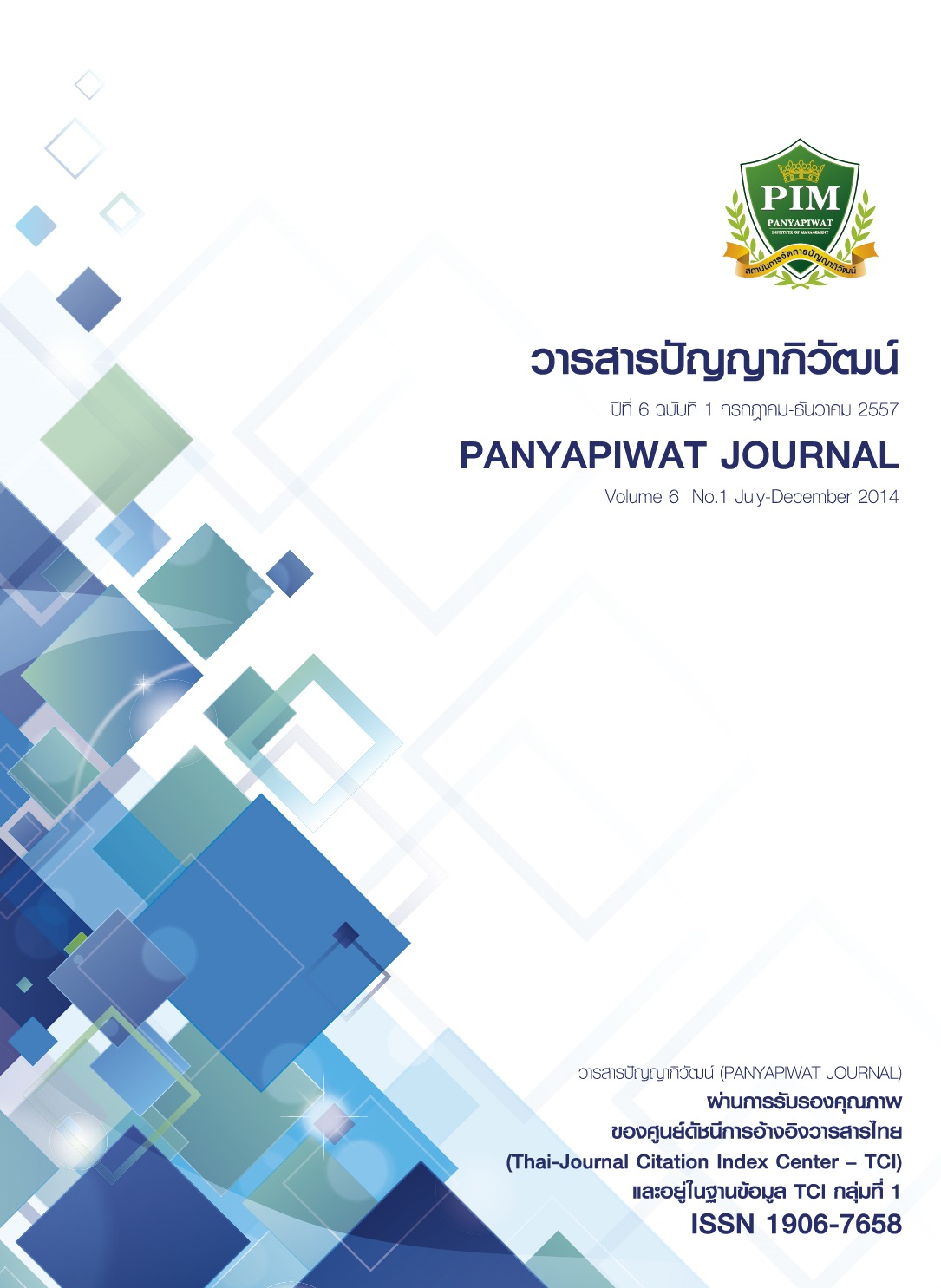สื่อการสอนช่วยลดภาระทางปัญญาสำหรับการศึกษา ในยุคดิจิทัล
Main Article Content
บทคัดย่อ
บทคัดย่อ
ขณะที่ผู้เรียนกำลังเรียนรู้หรือรับข้อมูลใหม่ๆ จากสื่อ จะเกิดภาระทางปัญญา เรียกว่า Cognitive Load ซึ่งภาระทางปัญญาจะเกิดขึ้นมากน้อยขึ้นอยู่กับระดับความยากง่ายของข้อมูลรวมไปถึงปริมาณข้อมูลและสื่อในการนำเสนอข้อมูล ซึ่งถ้าขณะเรียนรู้นั้นเกิดภาระทางปัญญามากเกินไป ก็จะทำให้ไม่เกิดการรับรู้ใดๆ ดังนั้นปัจจัยที่สำคัญ
ที่จะช่วยลดภาระทางปัญญาทำให้เกิดการเรียนรู้ได้อย่างมีประสิทธิภาพก็คือ สื่อและวิธีการนำเสนอ อย่างไรก็ตามเทคโนโลยีในยุคดิจิทัลเจริญรุดหน้า ทำให้มีสื่อรูปแบบใหม่ๆ เกิดขึ้น และได้รับความนิยมอย่างสูงในปัจจุบัน ได้แก่ สื่อดิจิทัลที่เป็นมัลติมีเดีย (Augmented Reality Augmented Books) และหนังสืออีบุ๊คแบบปฏิสัมพันธ์ (Interactive eBooks) เป็นต้น โดยกลุ่มสื่อเหล่านี้เป็นสื่อที่มีประสิทธิภาพเนื่องจากช่วยลดภาระทางปัญญา และดึงดูดความสนใจผู้เรียนได้เป็นอย่างดีทำให้สามารถเรียนรู้ เข้าใจเนื้อหาที่ซับซ้อนได้ง่ายขึ้นในเวลาอันสั้น
Abstract
Cognitive Load occurs when the learners are learning or being presented with new information. The major factor that contributes to cognitive load is the complexity of the information, number of elements and the presented media that need to be attended to. If cognitive load is too high or overload while learning, it will result in failure to learn. Therefore, the main factors to reduce the cognitive load are the design of learning media and how to present it. With today’s sophisticated digital technology, there are new popular media such as Augmented Reality Augmented Books and Interactive eBooks which are the effective teaching materials that are attractive and can reduce cognitive load. The learners are able to comprehend the difficult contents easily and rapidly.
Article Details
“ข้าพเจ้าและผู้เขียนร่วม (ถ้ามี) ขอรับรองว่า บทความที่เสนอมานี้ยังไม่เคยได้รับการตีพิมพ์และไม่ได้อยู่ระหว่างกระบวนการพิจารณาลงตีพิมพ์ในวารสารหรือแหล่งเผยแพร่อื่นใด ข้าพเจ้าและผู้เขียนร่วมยอมรับหลักเกณฑ์การพิจารณาต้นฉบับ ทั้งยินยอมให้กองบรรณาธิการมีสิทธิ์พิจารณาและตรวจแก้ต้นฉบับได้ตามที่เห็นสมควร พร้อมนี้ขอมอบลิขสิทธิ์บทความที่ได้รับการตีพิมพ์ให้แก่สถาบันการจัดการปัญญาภิวัฒน์หากมีการฟ้องร้องเรื่องการละเมิดลิขสิทธิ์เกี่ยวกับภาพ กราฟ ข้อความส่วนใดส่วนหนึ่งและ/หรือข้อคิดเห็นที่ปรากฏในบทความข้าพเจ้าและผู้เขียนร่วมยินยอมรับผิดชอบแต่เพียงฝ่ายเดียว”
References
สำนักงานพัฒนาธุรกรรมทางอิเล็กทรอนิกส์ (องค์การมหาชน) (2556). รายงานผลการสํารวจพฤติกรรมผู้ใช้อินเทอร์เน็ตในประเทศไทย. พิมพ์ครั้งที่ 1. กรุงเทพฯ: สำนักงานพัฒนาธุรกรรมทางอิเล็กทรอนิกส์.
BBC. (2010). Interactive eBook. Retrieved September 2013, from http://www.bbc.co.uk/programmes/p0198pwf/faq
Billinghurst, M. K. (2001). The Magic Book – Moving Seamlessly between Reality and Virtuality. IEEEComputer Graphics and Applications, 21(3), 6-8.
Cadavieco, J. F., Goulão, M. d., & Costales, A. F. (2012). Using Augmented Reality and m-Learning to Optimize Students Performance in Higher Education. Social and Behavioral Sciences, 46, 2970-2977. doi:http://dx.doi.org/10.1016/j.sbspro.2012.05.599
Hamilton, K. E. (2011). Augmented Reality in Education. Retrieved July 10, 2013, from http://wik.ed.uiuc.edu/articles/a/u/g/Augmented_Reality_in_Education_51fa.html
Hornecker, E., & Dünser, A. (2009). Supporting Early Literacy with Augmented Books – Experiences with an Exploratory Study. Proceedings of the German Society.
Jeroen, J., Van Merriënboer, J., & Sweller, J. (2005). Cognitive Load Theory and Complex Learning: Recent Developments and Future Directions. Educational Psychology Review, (2), 147-178.
Mayer, R. E., & Moreno, R. (2003). Nine Ways to Reduce Cognitive Load in Multimedia Learning. EDUCATIONAL PSYCHOLOGIST, 38(1), 43-52.
Rambli, M. W. (2012). Design consideration for Augmented Reality book-based application for collaborative learning environment. Computer & Information Science (ICCIS), 2012 International Conference on (Volume:2), pp. 1123-1126. Kuala Lumpur: IEEE. Retrieved from http://ieeexplore.ieee.org/xpl/articleDetails.jsp?tp=&arnumber=6297194
Schüler, A., Scheiter, K., Rummer, R., & Gerjets, P. (2012). Explaining the modality effect in multimedia learning: Is it due to a lack of temporal contiguity with written text and pictures? Learning and Instruction, 22(2), 92-102. doi:http://dx.doi.org/10.1016/j.learninstruc.2011.08.001
StoryToys. (2013). Grimm’s Rapunzel. Retrieved from https://play.google.com/store/apps/details?id=com.storytoys.GrimmsRapunzel.GooglePlay
Sweller, J. (2008). Evolution of human cognitive architecture. The Psychology of Learning and Motivation, 43, 215–266.
Sweller, J., Merrienboer, J. J., & Paas, F. G. (1998). Cognitive Architecture and Instructional Design. Educational Psychology Review, 10(3), 251-296.

